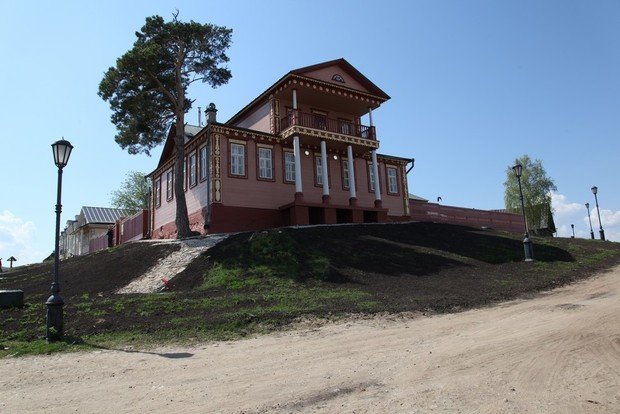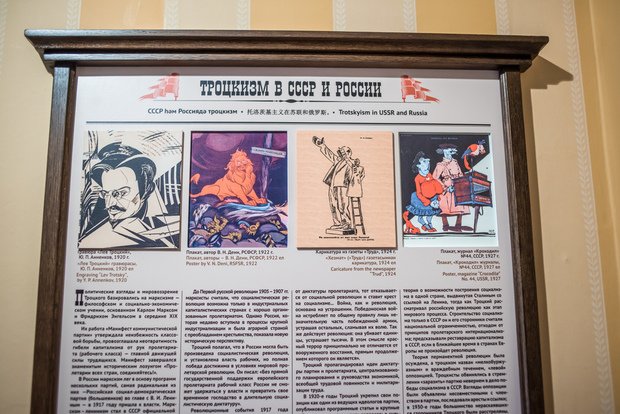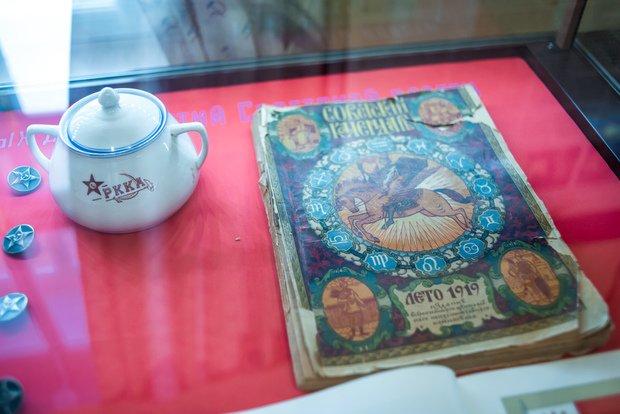Rustam Iskhakov dressed Trotsky and Larisa Reisner
Trotsky series that was shown on Channel One some time ago caused many complaints about the historical truth. Those who want to find the truth can be advised going to Sviyazhsk whose Civil War Museum has detailed authentic facts of Leon Trotsky's stay on the Kazan land. Realnoe Vremya tells the details.
Month in Sviyazhsk
The Civil War Museum in Sviyazhsk is, in fact, Leon Trotsky's museum, he is the main hero of the exposition here. The series, undoubtedly, is adorned by Konstantin Khabensky in the main role and that became the forte of the film. It's a pity that the series makers did not turn to the museum creators for true information. It's no use crying over spilt milk.
The museum is located in a cosy mansion, a listed building of the last century that is at the crossroads. The second floor of the mansion has a balcony. There is information that Leon Trotsky visited this house in summer 1918 for a month and even lived there sometimes. He received the parade in this house, the ''queen of the Russian revolution'' Larisa Reisner also lived here on a permanent basis.
Aybat design studio and its leading designer Aleksey Mescheryakov, director of the studio Sergey Nasekin, Director of Sviyazhsk Museum-Reserve Artyom Silkin and his deputy Elena Kartasheva created the museum where every square metre is informative.
In 1918, Sviyazhsk unexpectedly hosted military events, the situation in late summer wasn't the most pleasant for some parts of the Red Army. Almost all Middle Volga region was under control of Komuch's forces and rebellious Czech unions. For this reason, parts of the Reds and ships of the Volga Military Navy were massed near Sviyazhsk through the bridge over the Volga. Leon Trotsky's armoured train also arrived in Nizhnye Vyazovye station.
He supposed that the fight for Kazan was taking place next to Sviyazhsk. One of the chapters of his autobiography is called so – A Month in Sviyazhsk. Trotsky wrote later: ''After the fall of Simbirsk, my trip to the Volga was decided, which posed the biggest threat. I started to form the armoured train… I left Moscow on 7 August without knowing that Kazan had fallen.''

Leon Trotsky's style
The first floor of the Civil War Museum has several small rooms. The lobby has a whitened furnace where letters are seen, a resident of Sviyazhsk told about those events on the island. ''The Whites came and robbed, the Reds came and robbed,'' the situation on the island was so.
A figure of a Red Army fighter stands next to the furnace – he has a red leather pea coat, red budenovka, of course, red leather boots and a sword belt on. Trotsky had 40 such brave guards in his personal security staff. Leon Trotsky made up the kit for them himself.
Here is the very train – one of the rooms has a very detailed miniature of Nizhnye Vyazovye station, an armoured train was on the rails, Leon Trotsky arrived by it. Trotsky's armoured train became the first agit-train many of which travelled across the country then. Trotsky's trip from Moscow lasted for three days. But having known Kazan had fallen, he stopped in a safe place, of course. Nizhnye Vyazovye station near the Romanov Bridge over the Volga was this place.
The designers created a working miniature – the armoured train moves along the rails and produces team. Beat the Whites with the Red Wedge – such a motto was written on the armoured train. Famous El Lisitsky made it. The armoured train was full of mottoes: Everything for Protection of the World Revolution!, All-Hail World Revolution!.. The illustrative propaganda was thought out well. By the way, revolutionist poet Demiyan Bedny arrived on the same train.
The train has several head wagons, its own printing office. Trotsky published his own newspaper, all people who on the train had their own pins on the chest. Probably they were prototypes of modern-day badges. Trotsky's personal car arrived on the armoured train's platform. What is more, there were two more cars. Then Leon Trotsky's plane for quick needs was delivered. Trotsky can be called the first top PR manager. In this respect, everything in his armoured train was perfect, including even the tableware that was deliberately made with specific logotypes.
The artist's painting of the agit-wagons in that period approximately cost 700,000 rubles. To compare, average salaries in the backwoods in that period varied from 600 to 800 rubles. So Trotsky had quite big sums.
During the month, Trotsky constantly visited Nizhnye Vyazovye, made strategic plans but he also attacked Sviyazhsk. The memories of the place where he lived in Sviyazhsk differ, but most part mentions the house where the Civil War Museum is located now.
At the same time, Larisa Reisner who came via the Volga on the imperial yacht also was with Trotsky in the Kazan region. She was a poetess, opinion journalist, political worker of the Red Army, commissar of the Moscow General Staff, the prototype of the main heroine in Vsevolod Vishnevsky's play Optimistic Tragedy. There is a legend that being on the yacht, she engraved her autograph next to Empress Aleksandra Fyodorovna's signature on the glass with a diamond ring. The company in the Kazan region was famous at the time, what a series of photos in the museum hall is about. Apart from Trotsky and Reisner, there were Fyodorov, Raskolnikov, Latsetic, little talented General Stark, Kappel and Boris Savinkov.

Letter from Trotsky's grandson
The interiors of the museum made by the designers require a separate talk. There were created special wallpapers made by an English last-century technology. Theoretically, this mansion could have such. The curtains with Soviet symbols reproduce Varvara Stepanova's draft, who is Rodchenko's wife. The frame that rims the miniature of the station with the armoured train was made like a table and a big bookcase – objects of the 19 th century.
Even Trotsky's grandson Esteban Volkov who lives in Mexico was invited to create the exposition. Sergey Nasekin found Volkov's address and made him an offer that Trotsky's descendant immediately accepted. Nasekin asked him to send accurate sizes of Trotsky's bust that was created by Clare Sheridan – a British sculptor who supported leftist views. She came to Moscow and created several busts of famous people of that time, including Trotsky.
It was decided to make a copy of the bust by photos. But nobody knew its sizes. And the original bust is stored in Leon Trotsky's house-museum in Mexico. Esteban Volkov is the director of this museum. ''We found the address of the museum on the Internet and wrote Volkov a letter, translated it into English and Spanish, described that we're creating a museum and asked to send the accurate sizes of the bust. We added we were sending him a proletarian salute. The answer came two days later. Volkov carefully measured the sizes,'' Sergey Nasekin tells. ''There was also an idea to invite Trotsky's grandson to the museum's opening. We sent him an invitation but he refused and explained it was difficult to withstand a flight from Mexico to Kazan at his age.''
Very Leon Trotsky is also present in the museum. Firstly, a 5-minute documentary can be watched on the screen about Trotsky's trip to the Kazan region where the hero is always seen. Secondly, Trotsky's cabinet is in one of the halls where the reconstructed figure of Leon Trotsky can be seen at the table.
A female figure in a linen ecru suit is next to the window – it is Larisa Reisner. Kazan designer Rustam Iskhakov sewed the costumes for the heroes after studying historical photos. According to the idea of the museum creators, this scene that resembles Reisner's report to Trotsky could be real. Trotsky sent Reisner to Kazan for exploration. She went on foot and was reporting what she had seen and heard in the city four days later when she was back, of course.
A French-born Morse telegraph made in 1916 is on the table next to Trotsky. The designers had to sweat blood to find it. There were telegraphs that were made later, but they wanted this one. As a result, one of Sergey Nasekin's friends bought the machine in a flea market in Paris and brought it to Kazan. There were many surprising stories while creating the museum as if somebody had helped the designers.
For instance, a real staff map of 1918 can be seen in the museum that they also spent much time to find. Once Artyom Silkin was in Saint Petersburg and visited an antiquarian shop not far from the Hermitage. He found the staff map of our places that was directly linked with military operations during Trotsky's stay!

Parade under the balcony
The museum partially illuminated a mysterious story that has been concerning many minds for a long time – was the monument to Judas Iscariot placed in Sviyazhsk at Trotsky's initiative or not? A unique book The Red Garden can be seen in the exposition. It was translated and printed several years ago at Artyom Silkin's initiative, it tells about this episode.
Henning Kehler is the author, a representative of the Danish diplomatic service who was charged with dealing with cases of military prisoners in Russia who were many after WWI here. So Kehler travelled across the country and was in Trotsky's armoured train and in Svyazhsk. In the book, the city is called Sviyagorod. The author obviously had a gift for writing. He clearly invented something and made fantasies, but there are things that he tells accurately.
He describes a house with columns where the president of the local council and governor of the city received the parade. One can guess Leon Trotsky was this character. Larisa Reisner is featured in the book named Dolly Mikhailovna. The house with columns is the same house where the Civil War Museum is now.
This is who Kehler describes Trotsky: ''His eyes were especially remarkable. They were without real expression, but at times they flamed and a reddish light seemed then to radiate from them. Altogether, he gave the impression of being a man of superior gifts, but undeniably not quite all there.''
The author writes that after the parade he was invited to the opening of the monument of Judas as '' the first revolutionist''. If it was really so, how did Trotsky behave? Kehler describes him as follows: ''He whispered, ''I will confide in you. In me is truth. I am the resurrected saviour of the new time. I am...'' No doubt this person was crazy. He believed he was Judas. Unfortunately, the museum creators didn't manage to find any other evidence about the monument to Judas was in Sviyazhsk.